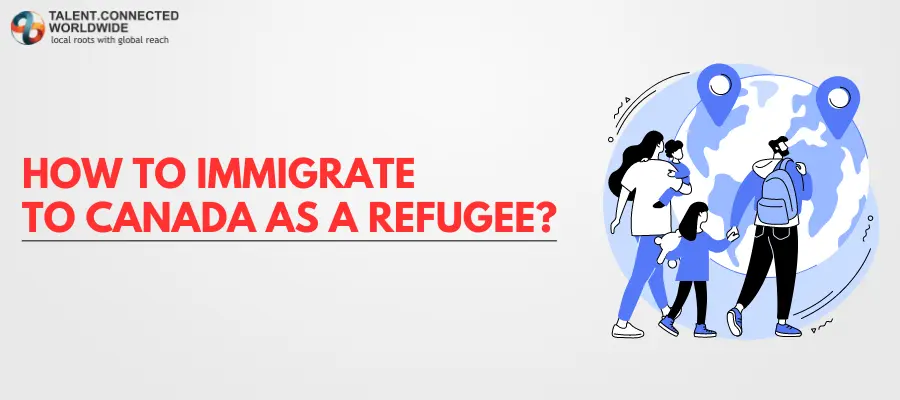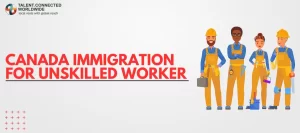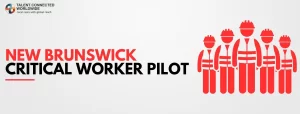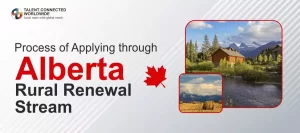
If you are someone forced to flee from your home country due to horrific reasons or fear of persecution, you may be eligible to come to Canada as a refugee. Canada offers several immigration options for refugees and even gives them the opportunity to work in the country and make a living. Let’s see how to immigrate to Canada as a refugee and how the Canadian refugee system works.
This article includes:
- How are Refugees different from Immigrants?
- Canadian Refugee System: How it works
- How to resettle in Canada: For Refugees
- Sponsorship Programs for Refugees in Canada
- Economic Mobility Pathways Pilot (EMPP)
- Your Rights as a Refugee
How are Refugees different from Immigrants?
Immigrants and refugees are not the same. A person looking to immigrate to Canada is not running away to save their life. They are fully conscious of their decision to move to another country because they are looking to elevate their living standard or due to some other reason.
However, a person fleeing from their home, the country that they used to live in since birth or for a long time, is different. They are forced by their situations to leave with their family and run for a safer option. And that’s where immigrants and refugees differ.
Also, the application process for refugees does not work the same way it does for immigrants. This means, applications for both refugees and immigrants are processed separately.
Now that we understand how immigrants and refugees are different, let’s talk about how the Canadian refugee system works.
Download Free Immigration and PR Guide PDF
Canadian Refugee System: How it works
Canada is a country that welcomes different kinds of people wholeheartedly. This makes Canada a very welcoming country and quite popular among the immigrants and refugees.
A refugee may be eligible to apply for Canada PR and subsequently, even Canadian citizenship if they are eligible for it.
Canada’s refugee system is separated in two parts, the first one works for people who need protection from outside Canada, and the second one for people who are making refugee claims from inside Canada.
These are:
1. The Refugee and Humanitarian Resettlement Program
2. In-Canada Asylum Program
1. Refugee and Humanitarian Resettlement Program
Every year, there are millions of refugees who are forced to leave their home country either due to war, human rights violations or violence. Canada is one of the countries that hosts a large number of refugees and it has different programs to resettle these refugees as well.
The resettlement programs available are:
- the United Nations Refugee Agency (UNHCR)
- Private sponsors
- Blended Visa Office-Referred (BVOR) program
Groups that can sponsor refugees are:
- Sponsorship Agreement Holders (SAHs)
- Constituent Groups (CGs)
- Groups of Five (G5), and
- Community Sponsors (CSs)
2. In-Canada Asylum Program
The In-Canada Asylum Program works for specific groups of people only. It is not open for everyone living in Canada. Basically, it protects people who are:
- at risk of torture, some severe kind of punishment or suffering from cruel torture back in their home land
- in fear of persecution
Claiming refugee status from inside Canada: Overall Process
As mentioned above, not everyone is eligible to apply for asylum from inside Canada. Eligible individuals are those who are
- at risk of cruel punishment
- at risk of torture
- facing life and death situation
Moreover, to make a refugee claim, one must be in Canada at the time and also cannot be subjected to a removal order.
So, let’s see who is eligible to apply first and then discuss the remaining matters.
Who is eligible?
Even if someone makes a refugee claim, Immigration and Refugee Board of Canada (IRB) will decide whether the claim is genuine or not. The IRB is the autonomous body that makes decisions regarding matters on refugees and immigration. IRCC decides whether to refer the refugee claim to the IRB or not.
How to apply for a refugee claim in Canada?
To be able to make a refugee claim, you must be in Canada and be eligible for the same.
There are two ways to make a refugee claim, you can either make the claim:
- at a port of entry
- or online, after arriving in Canada
Making a claim at a Canadian Port of Entry
When you arrive at a Canadian Port of Entry, a Canada Border Services Agency’s (CBSA) officer will require you to fill out the necessary forms. Moreover, they’ll ask you questions about what happened to you.
Also, they’ll collect your documents and biometrics in order to establish your identity.
What happens after you apply?
When you are filing for a refugee claim at the post of entry, one of the following things can happen:
1. When the CBSA is convinced that your refugee claim is eligible, they’ll provide you with a Refugee Protection Claimant Document (RPCD), a claim form, a confirmation of the referral letter and further instructions on how to take the medical exam. To complete the refugee claim, you need your UCI, date of birth, and application number. This information is found on your RPCD and confirmation of claim letter.
2. They will schedule an appointment for an interview and send you a letter regarding the same. You will need to complete the medical exam in this case as well as attend the interview.
3. The CBSA officer will instruct you to complete the claim online. So, with their instructions, you will complete filing for refugee claims online along with completing your medical exam.
4. The CBSA officer may find your claim ineligible.
Making a claim online (from inside Canada)
If you want to submit a claim from inside Canada:
- must submit a claim for both yourself and your family at the same time
- in order for your file to be free of any problems, use common characters
Follow the given instructions to submit a claim in the IRCC portal:
- First of all, you need to get an invitation code to create your account for the first time
- Secondly, create the portal account using the code IRCC sent you
- After signing in, choose the option of “Make a Refugee Claim”. There will be a form, and you’ll need to answer all the questions on it. You will have to complete the form in about 90 days from the day you start your claim.
What happens after you apply?
You will get an acknowledgement of a claim letter and instructions on how to take the medical exam. When IRCC is done scheduling your in-person appointment they’ll send you a letter with the details.
This interview decides whether the person is eligible for the claim or not.
What if the claim is eligible?
First of all, if your claim is found eligible, you must go to a hearing. In case IRCC refers your claim to the IRB, they will schedule a hearing. You will receive a notice regarding the hearing.
The notice will let you know when and where the hearing is. Along with this, it will also let you know when to go there.
In this hearing, IRB will make the final decision of either approving or denying your claim. In case of:
- approval- you get the status of “protected person”, and can stay in Canada, apply for permanent residency
- rejection- leave Canada or appeal the IRB’s decision
How to resettle in Canada: For Refugees
If you are looking to resettle in Canada as a refugee, you must be referred by the Nations Refugee Agency – The United Nations Refugee Agency (UNHCR), any private sponsorship group, or a designated referral organization.
Since a refugee cannot apply for referral by themselves, they must belong to at least one of the refugee classes:
- Convention Refugee Abroad Class
- Country of Asylum Class
Eligibility Requirements
Let’s check out the eligibility criteria for each of these classes below.
1. Convention Refugee Abroad Class
People are found eligible under this class, if they:
- are not in their home country
- are unable to return to their country because they fear persecution based on their religion/ race/ nationality/ political opinion/ social group
People under this class may be sponsored by:
- the Canadian government
- a group of people
- both (blended visa office-referred refugees)
2. Country of Asylum Class
Under the country of asylum class, people are found eligible if they:
- are not on their homeland/ in the country they used to usually live in
- were denied basic human rights continuously
- were seriously affected by armed conflicts or caught in the civil war
People under this class may be eligible to be privately sponsored. Further, if you have enough funds, you may sponsor yourself and your family after arriving in Canada. Though you can sponsor yourself, you still need to be referred.
Sponsorship Programs for Refugees in Canada
Private Sponsorship of Refugees (PSR) program allows Canadians to resettle those individuals or their families who qualify as refugees under Canada’s Refugee and Humanitarian Resettlement Program.
Private sponsors have to support the refugee for up to 1 year or so. Further, this support includes:
- monthly costs for basic requirements
- start-up costs which means cost of clothing, furniture etc
- Supporting the refugees emotionally and socially
Groups that can support refugees are:
- Sponsorship Agreement Holders (SAHs)
- Groups of Five (G5), and
- Community Sponsors (CSs)
The Blended Visa Office-Referred (BVOR) program helps groups sponsor refugees that need it the most. They also lower the costs of sponsorship.
In case you are sponsoring a refugee with special needs, the Joint Assistance Sponsorship (JAS) program will help the refugee sponsoring group. In such cases, only SAHs (along with Constituent Groups) are eligible to sponsor.
In case you are sponsoring a refugee you know already, they need to be eligible under the Private Sponsorship of Refugees (PSR) program. Also, the whole process will depend on which type of sponsorship group you are.
Next, let’s talk about the immigration program that not only works for immigrants but also helps refugees resettle.
Economic Mobility Pathways Pilot (EMPP)
EMPP, short for Economic Mobility Pathways Pilot, is a combined pathway for economic immigration as well as refugee resettlement.
This means, it helps refugees with adequate skills to immigrate to Canada. Skilled refugees may immigrate through already existing economic programs.
Moreover, it also gives employers a chance to select qualified candidates from a new pool. This means, even more skilled candidates are available to fill the vacant job positions.
How EMPP works?
Now, there are two ways to apply for the EMPP, these are:
- You can either apply directly to IRCC for EMPP, or
- Apply through the Atlantic Immigration Program (AIP), Provincial Nominee Program (PNP), Rural and Northern Immigration Pilot (RNIP)
Who is eligible?
To be eligible for the EMPP, there are three different kinds of eligibility requirements that one needs to meet. These are:
- must be a refugee/ displaced person
- must be eligible through whichever way you are applying
- be admissible to Canada
How to apply through Economic Mobility Pathways Pilot?
One can apply for the EMPP either by themselves or take help from a non-governmental organization/partner.
Before applying, you must submit proof of your current refugee status. This proof must be with one of these:
- a refugee certificate with the UNRWA (United Nations Relief and Works Agency for Palestine Refugees in the Near East)
- a positive Refugee Status Determination (RSD) which is provided by the United Nations Refugee Agency or even a refugee-hosting state
- prove being recorded/registered as a concerned person by the UNRWA (if you still don’t have a refugee certificate)
- proof of being recorded/registered as a concerned person by the UNRWA (if you don’t a positive RSD)
- proof of temporary protection status
- a copy of durable solution form, which must be completed
In case you do not possess any of these documents, you still have the option to work with a partner. Your partner can issue you a “trusted partner referral letter”.
Now comes the part where you actually file the application. Let’s check out how to apply through each EMPP category:
Applying through Federal EMPP
This one means you are applying based on your work experience, language skills, and education. So, you need to fill out any one application, even if you don’t have a job offer.
Applying through Regional EMPP
This one requires you to complete two applications:
- First application is for the Canada immigration program you will be immigrating through
- Second application is for the regional EMPP
What happens after you apply?
Once the applications are submitted, IRCC will receive them in two stages:
- they’ll check if the forms are included in the application or not
- they’ll review the applications and decide whether you are eligible as well as admissible to Canada or not
If your application is approved, IRCC will issue you:
- a visa so that you can travel to Canada. They may issue you a single journey travel document if you don’t have a valid passport
- they will also issue you a Confirmation of Permanent Residence (COPR)
Your Rights as a Refugee
Under the Canadian Charter of Rights and Freedoms, all persons are protected in Canada. This means, even if you are a refugee in the country, you still have the rights.
1. In terms of employment
You can submit a separate work permit application if you didn’t submit one with your refugee claim.
You must include a copy of the refugee protection claimant document with your work permit application. Along with this document, don’t forget to include a proof that you took an immigration medical examination.
Along with the medical examination, give proof that you are in need of a job so that you can pay for your basic requirements.
If you are requesting a permit for your family members as well, provide proof that they are in Canada with you and they’re also applying for refugee status.
Since you are still waiting for a decision on your refugee claim, you don’t need to pay any fees for the permit.
2. In terms of education
Even while you wait for your refugee claim to be approved, you may apply for your study permit so that you can continue your studies.
Further, don’t forget to get an acceptance letter from a DLI or else your application won’t be accepted.
In case you have an acceptance letter, you may apply for the study permit at the same time as when you are applying for your refugee status.
Further, your family members may also be eligible if they are also applying for refugee claims. If your family includes minor children, you don’t need to get a study permit for them to go to kindergarten/elementary school or even secondary school.
Don’t forget to fill out the form below to get some insights and advice from our experts!
Thinking of safe and successful Canada immigration? Think Talent Connected Worldwide.
Don’t waste your time







